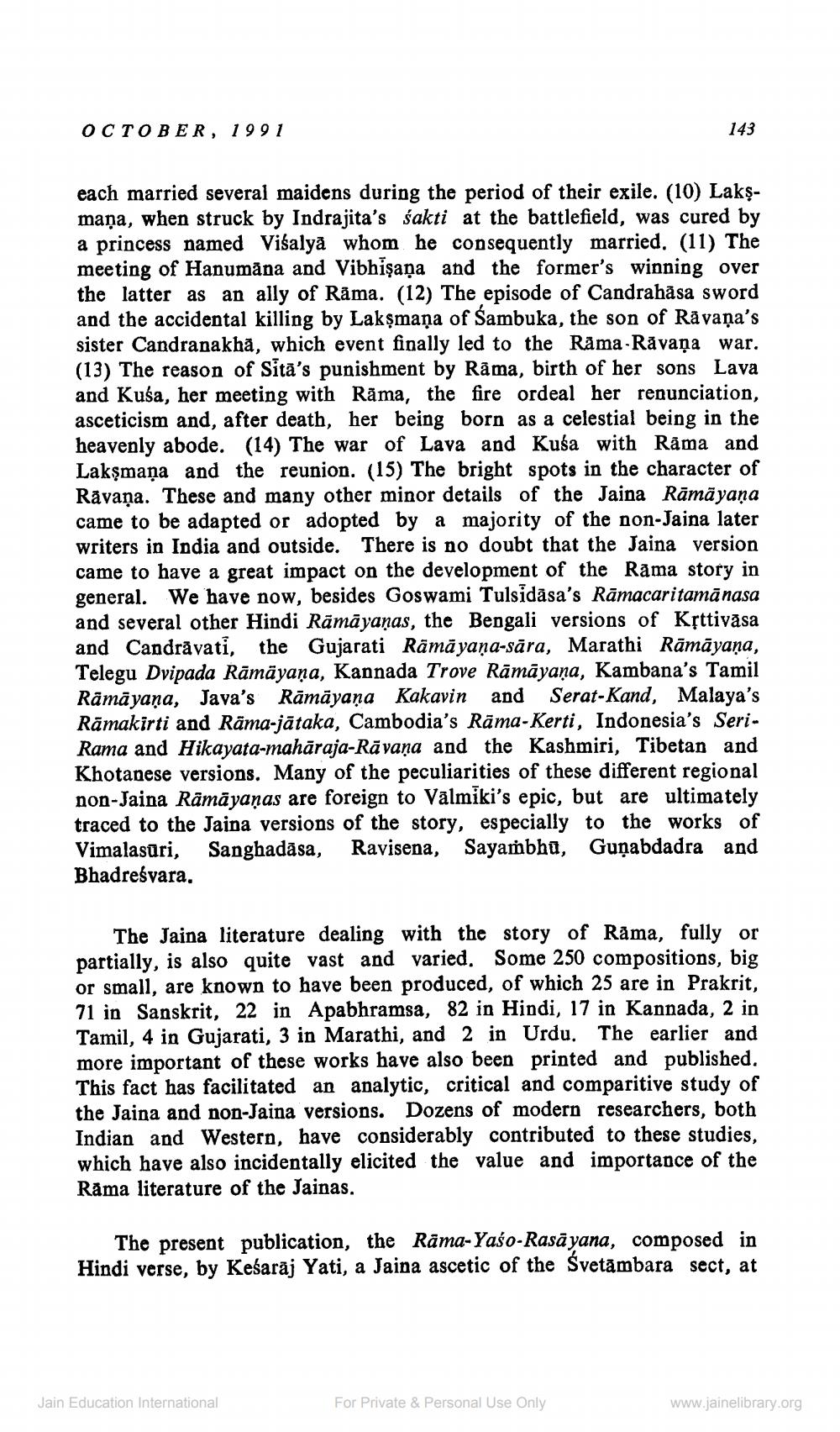Book Title: Jain Journal 1991 10 Author(s): Jain Bhawan Publication Publisher: Jain Bhawan Publication View full book textPage 7
________________ OCTOBER, 1991 143 each married several maidens during the period of their exile. (10) Lakşmaņa, when struck by Indrajita's sakti at the battlefield, was cured by a princess named Višalyā whom he consequently married. (11) The meeting of Hanumāna and Vibhişaņa and the former's winning over the latter as an ally of Råma. (12) The episode of Candrahāsa sword and the accidental killing by Lakşmaņa of Sambuka, the son of Råvaņa's sister Candranakha, which event finally led to the Rama-Răvaņa war. (13) The reason of Sita's punishment by Rama, birth of her so and Kuśa, her meeting with Rāma, the fire ordeal her renunciation, asceticism and, after death, her being born as a celestial being in the heavenly abode. (14) The war of Lava and Kusa with Rama and Lakşmaņa and the reunion. (15) The bright spots in the character of Rāvana. These and many other minor details of the Jaina Rāmāyana came to be adapted or adopted by a majority of the non-Jaina later writers in India and outside. There is no doubt that the Jaina version came to have a great impact on the development of the Rama story in general. We have now, besides Goswami Tulsidasa's Rāmacaritamānasa and several other Hindi Rāmāyaṇas, the Bengali versions of Křttivāsa and Candrăvati, the Gujarati Rāmāyaṇa-sāra, Marathi Rāmāyaṇa, Telegu Dvipada Rāmāyaṇa, Kannada Trove Rāmāyaṇa, Kambana's Tamil Rāmāyana, Java's Rāmāyaṇa Kakavin and Serat-Kand, Malaya's Rāmakirti and Rama-jātaka, Cambodia's Rāma-Kerti, Indonesia's Seri. Rama and Hikayata-mahāraja-Rāvana and the Kashmiri, Tibetan and Khotanese versions. Many of the peculiarities of these different regional non-Jaina Rāmāyanas are foreign to Valmiki's epic, but are ultimately traced to the Jaina versions of the story, especially to the works of Vimalasūri, Sanghadāsa, Ravisena, Sayambhu, Guņabdadra and Bhadreśvara. The Jaina literature dealing with the story of Rāma, fully or partially, is also quite vast and varied. Some 250 compositions, big or small, are known to have been produced, of which 25 are in Prakrit, 71 in Sanskrit, 22 in Apabhramsa, 82 in Hindi, 17 in Kannada, 2 in Tamil, 4 in Gujarati, 3 in Marathi, and 2 in Urdu. The earlier and more important of these works have also been printed and published. This fact has facilitated an analytic, critical and comparitive study of the Jaina and non-Jaina versions. Dozens of modern researchers, both Indian and Western, have considerably contributed to these studies, which have also incidentally elicited the value and importance of the Rama literature of the Jainas, The present publication, the Rāma-Yaśo-Rasāyana, composed in Hindi verse, by Keśarāj Yati, a Jaina ascetic of the Svetāmbara sect, at Jain Education International For Private & Personal Use Only www.jainelibrary.orgPage Navigation
1 ... 5 6 7 8 9 10 11 12 13 14 15 16 17 18 19 20 21 22 23 24 25 26 27 28 29 30 31 32 33 34 35 36 37 38 39 40 41 42 43 44 45 46 47 48 49 50 51 52 53 54 55 56 57 58
